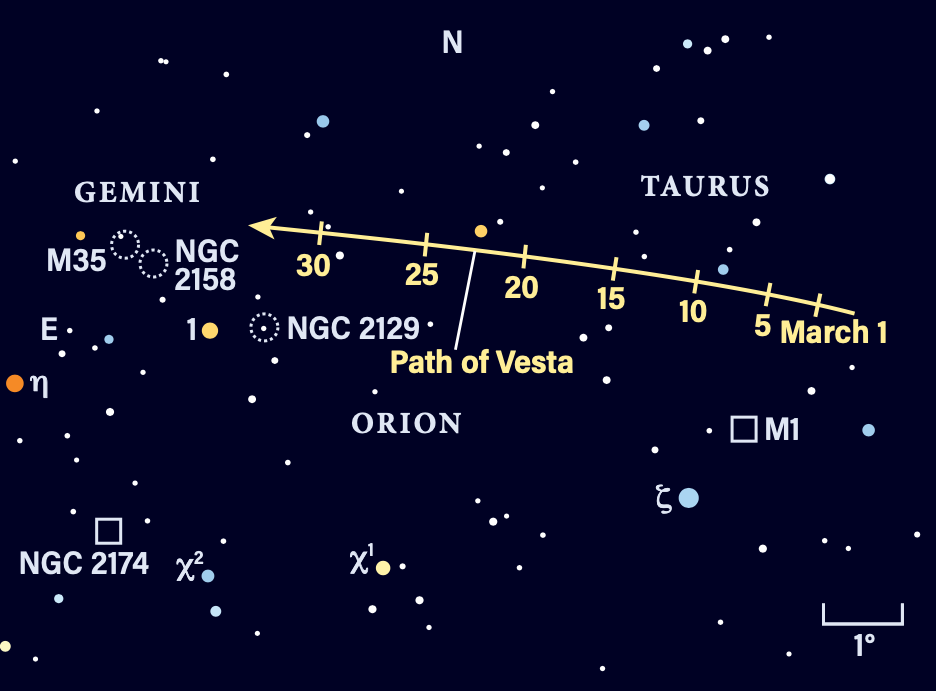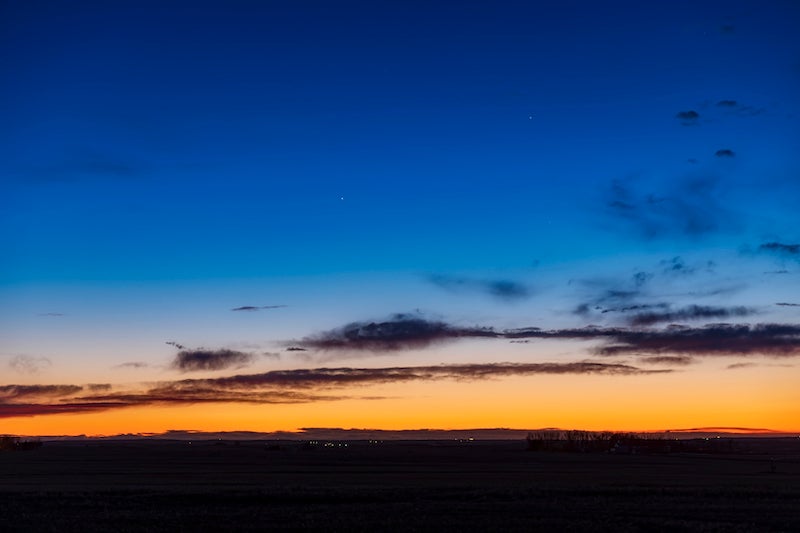
The evening sky of springtime hosts Mercury, Jupiter, and Uranus. It’s a good last chance to catch the richness of the jovian atmosphere, plus a few interesting events involving the Galilean moons. Venus dominates the morning sky, visible in brightening twilight, while Mars and Saturn progressively come into view late in the month. And if we’re lucky, Comet 12P/Pons-Brooks might put on a good show for binoculars as it crosses Andromeda, Pisces, and Aries.
Mercury reaches its best evening appearance for the year as it extends its elongation from the Sun out to 19° by March 24. However, it is brighter before this date — catching it in mid-March at magnitude –1.5 on the 9th is likely one of your earliest views. While it is bright, it stands only 3° high in the western sky 30 minutes after sunset and sets shortly before 7 p.m. local time.
After the clocks move forward an hour on the 10th, a crescent Moon aids finding Mercury on the 11th. The thin crescent stands 15° high 30 minutes after sunset and Mercury is 4.5° high, to Luna’s southwest. Through a scope, Mercury spans 6″ and is almost full at 89 percent lit.
The phase changes quickly for the speedy planet. Shining at magnitude –1.2 on the 15th, Mercury is now easy to spot above the western horizon and remains visible for more than an hour after sunset. The gibbous disk is 11 percent narrower, at 78 percent lit. A week later, on the 22nd, Mercury reaches 50 percent lit and spans 7″. It remains bright, now at magnitude –0.5, and stands 6° high a full hour after sunset. You might even spot some of the fainter stars of Pisces in the background. Jupiter stands 24° away in neighboring Aries.
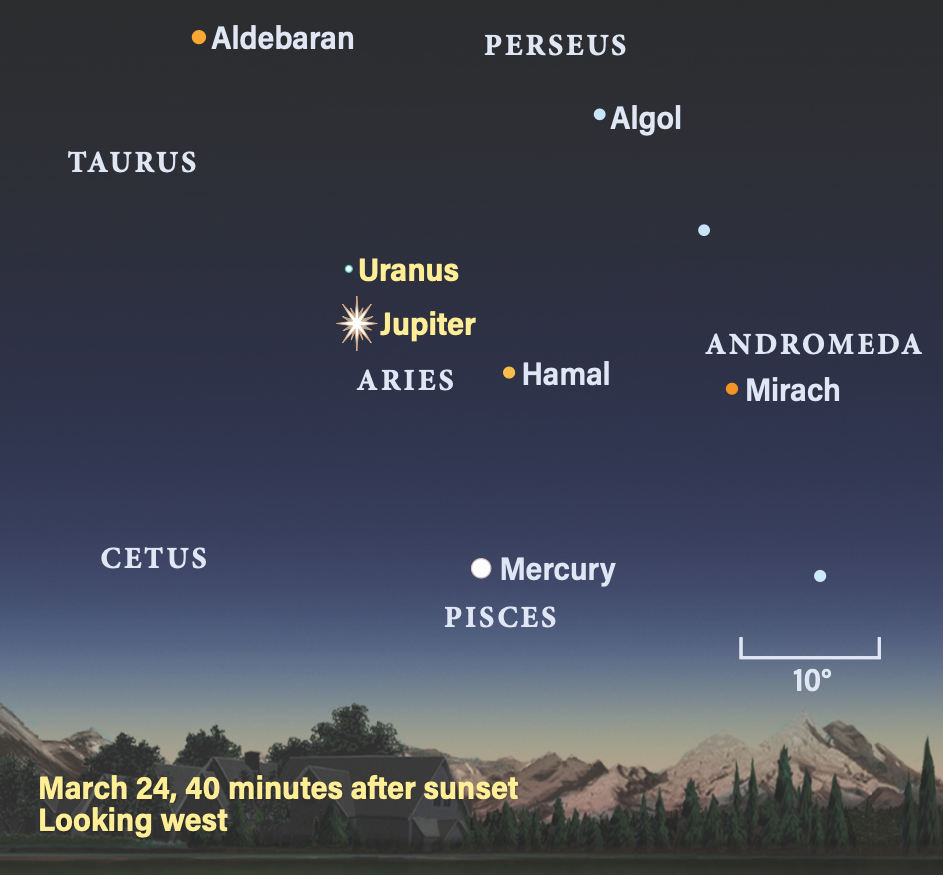
Two days later (March 24), Mercury reaches its greatest elongation, now at magnitude –0.3 and on view for more than an hour after sunset. Only four days later (the 28th), it’s dimmed to magnitude 0.4 and shows a fine 27-percent-lit crescent spanning 8″. Mercury is moving rapidly toward conjunction with the Sun and quickly dims as the crescent diminishes, dropping to magnitude 1 by the end of March.
Jupiter is a brilliant object high in the western sky this month. It remains visible until nearly 11 p.m. local time in early March. However, the observing window narrows at the end of the month, when Jupiter stands only 15° above the horizon at 9 p.m. local daylight time and sets within 2.5 hours.
Early March is the best period to catch good views of Jupiter. Its higher elevation avoids the hazy and turbulent air nearer the horizon, which results from the Sun heating the ground during the spring daytime. Starting the month at magnitude –2.2, it’s hard to miss the planet’s location within Aries, one of the fainter constellations along the ecliptic.
Try viewing the bright planet in twilight to minimize the intense glare. The apparent diameter of Jupiter spans 36″ on March 1 and drops to 34″ by March 31. Telescopes reveal the four Galilean moons as well as a rich display of atmospheric features crossing the disk. Most apparent is the pair of dark equatorial belts straddling the equator. The Great Red Spot comes into view every other day or so as it rounds the planet once every 10 hours.
Io, Europa, Ganymede, and Callisto orbit Jupiter with periods ranging from nearly 1.8 to 17 days. As the Jupiter observing season comes to an end, the number of transits and occultations diminishes. Even so, there’s a couple you can catch.
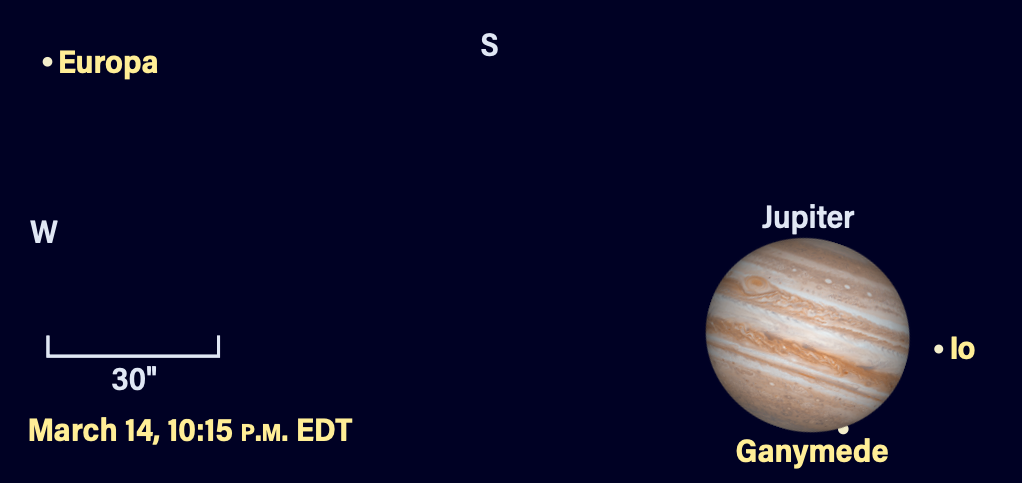
Watch on March 8 as Europa is visible early in the evening, then disappears behind Jupiter’s limb just after 9:30 p.m. CST. On March 14, lucky observers from the eastern two-thirds of the country experience Ganymede reappearing from behind Jupiter at 10:09 p.m. EDT (note the change to DST), just as Io is approaching the same limb to begin a transit. Io begins transiting around 10:40 p.m. EDT.
On March 17, Europa is transiting as darkness falls in the Midwest. The moon is followed at length by its shadow, which appears shortly before 10:35 p.m. EDT.
Wrap up the month with a fine transit of Io and its shadow on March 30. It’s underway by nightfall across the Midwest. Io leaves the disk at 10:22 p.m. CDT, with Jupiter very low in the western sky. The shadow departs 48 minutes later, visible from the Pacific time zone and some parts of the Mountain time zone.
If you’re wondering why Callisto isn’t undergoing any events, it’s because the tilt of the satellites’ orbital plane relative to our line of sight is sufficient that Callisto misses Jupiter. You can see this on March 18, when the large moon skirts above the northern edge of the planet.
March opens with Uranus 8° northeast of Jupiter; the planets close in to 3.5° on the 31st. Uranus shines at magnitude 5.8 and is most easily spotted in binoculars. At the end of March Uranus stands 2° south of Delta (δ) Arietis, a 4th-magnitude star also known as Botein, located 9.5° southwest of the Pleiades (M45).
A fine crescent Moon joins Uranus and Jupiter March 13, the same night 243 years ago that William Herschel discovered Uranus from his backyard in Bath, England. Uranus lies about 6° due east of the Moon. This distant planet, once thought to be at the outer edge of the solar system, now lies 20.1 astronomical units (1.87 billion miles) from Earth and through a telescope shows off a tiny, bluish-green, 3″-wide disk. (One astronomical unit, or AU, is the average Earth-Sun distance.)
On March 30 and 31, Comet 12P/Pons-Brooks stands within 1° of Hamal, the brightest star in Aries. The comet could be an easy binocular object. Last seen in 1954, it underwent outbursts that were also observed in 2023, so there’s a chance it could even exceed binocular visibility for short periods. In the second week of March the comet lies in Andromeda, passing 9° south of M31 on the 12th. After crossing northern Pisces, Pons-Brooks lies 3° due south of M33, the Triangulum Galaxy, on March 23.
The morning sky hosts Venus, Mars, and Saturn, although the viewing window is limited.
On March 1 you’ll find Venus and Mars less than 4° apart and very low in the eastern sky less than an hour before sunrise. Venus rises about an hour before the Sun and shines at magnitude –3.9, an easy object to spot. Mars, on the other hand, glows at magnitude 1.3 and will require binoculars to find in the rapidly growing twilight. Each morning Venus pulls farther away from Mars; the pair is joined by the waning crescent Moon on March 7 and 8. Look on the 7th for the slender crescent 18° west of Venus — Mars lies just above a point midway on a line between them. The crescent Moon is more difficult to spot on the 8th, almost 6° south of Venus. The Moon stands only 1° high 30 minutes before sunrise and competes with the bright twilight.
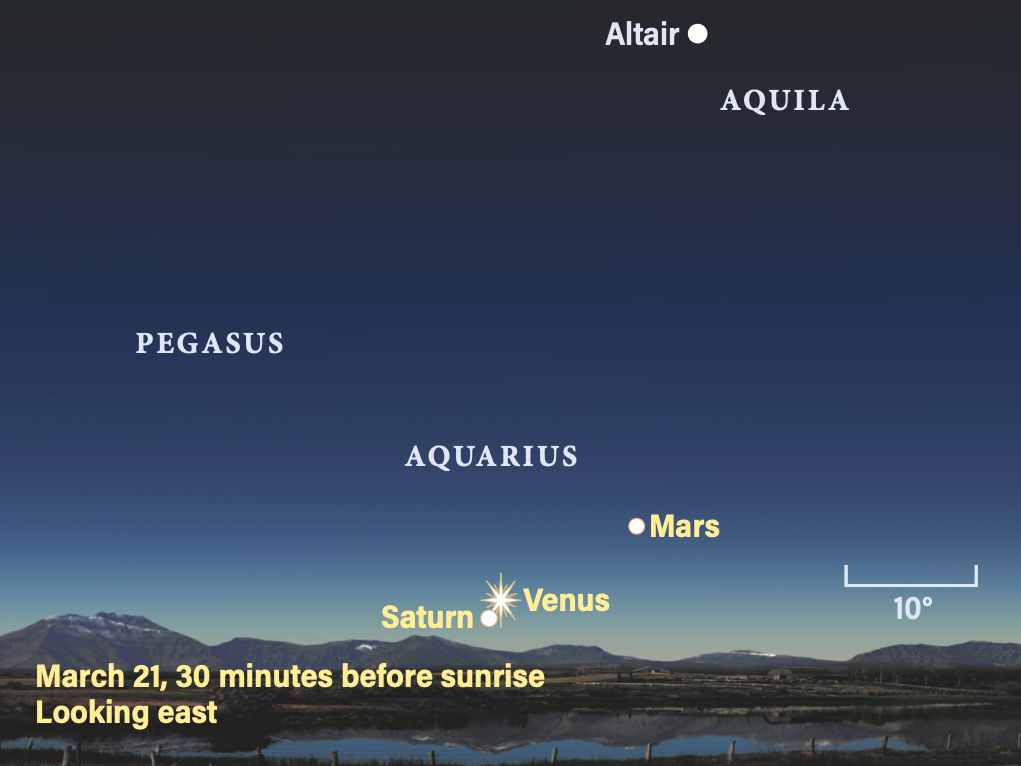
Venus passes 0.3° north of Saturn on March 21, the latter of which recently came out of solar conjunction. It’s a difficult pairing to see: Venus stands 1° high 30 minutes before sunrise, and Saturn glows at magnitude 1 some 40″ to its east. Binoculars will aid in spotting Saturn, while Venus is easy to follow as the sky brightens.
On the last day of March, Venus, Saturn, and Mars are lined up along the ecliptic, spanning 17.5°. Mars rises around 5:30 a.m. local daylight time, followed 20 minutes later by Saturn. Mars is now magnitude 1.1 and Saturn is still magnitude 1. Look for the pair about 45 minutes before sunrise, low in the east. Venus rises 15 minutes later; as twilight swallows Mars and Saturn’s glow, Venus remains bright enough to be seen.
Neptune reaches conjunction with the Sun on the 17th and is not visible this month.
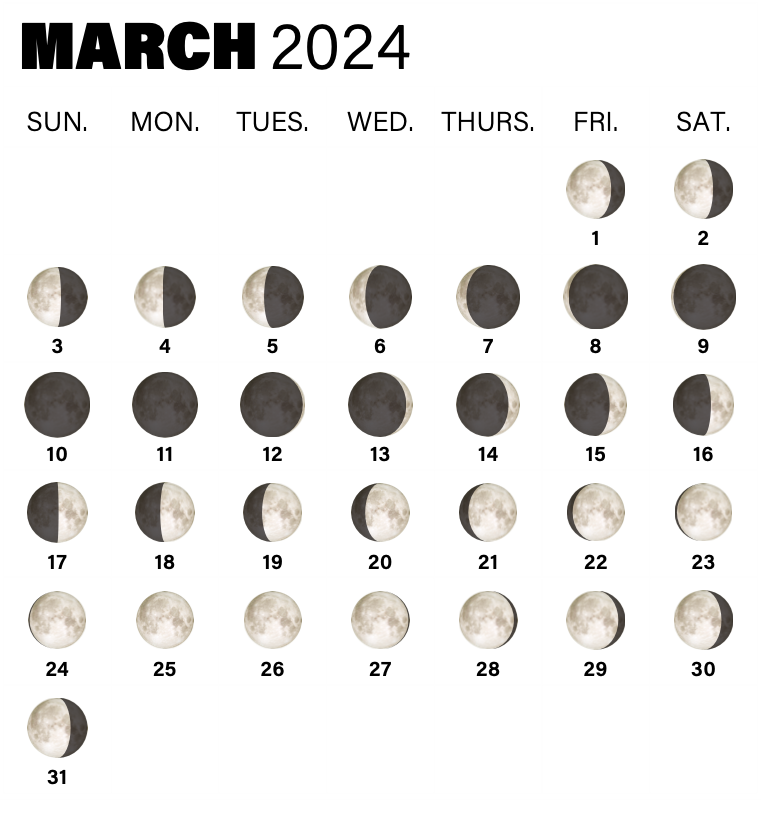
Rising Moon: Ticks on the timeline
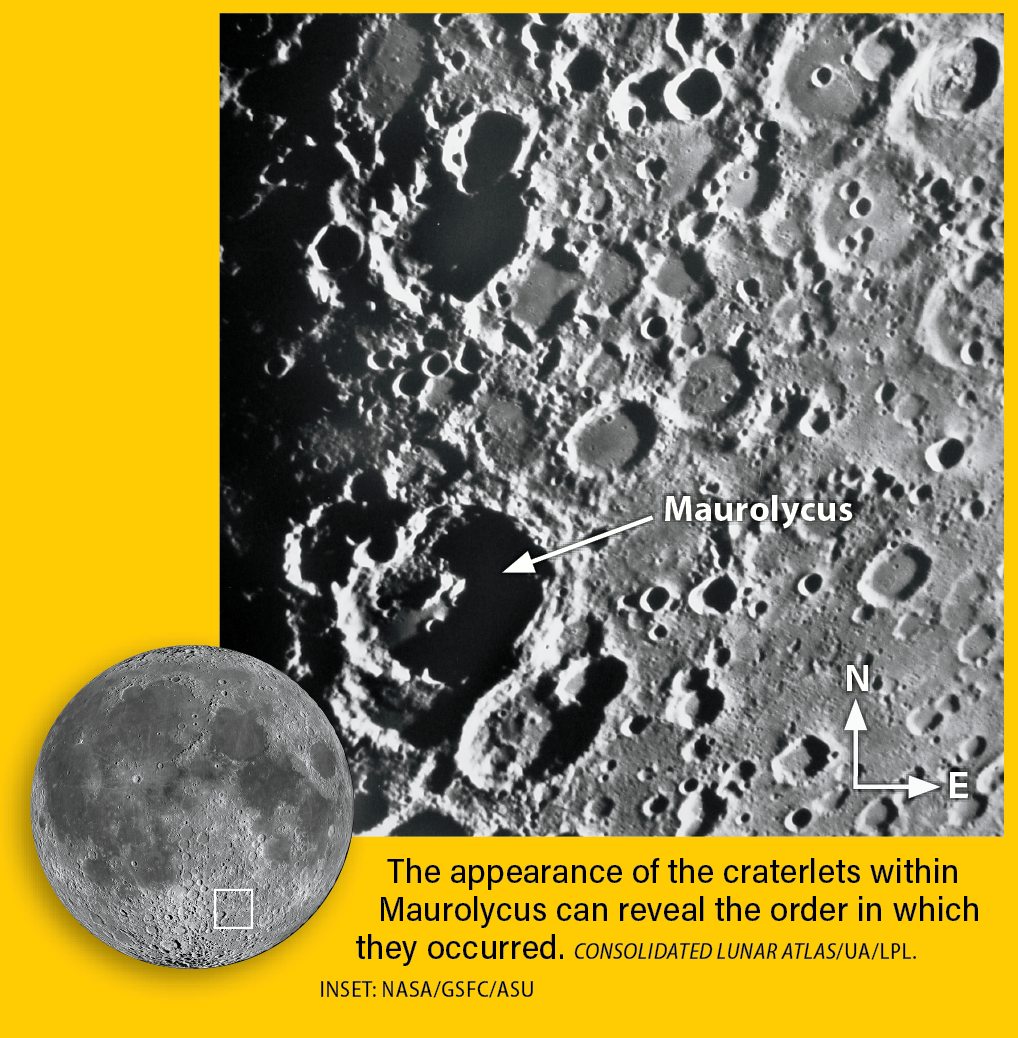
Riding high in the southwest during spring evenings, our sister Luna is bright and white. On the evening of the 16th, at First Quarter, soak in the breathtaking series of seas in the north, then scan southward across the craters lining the day-night terminator.
Anchored in the southernmost third of the lunar disk is the large crater Maurolycus, spanning some 70 miles and named after an Italian mathematician who disagreed with Copernicus’ Sun-centered solar system. The impact that carved out this classic beauty occurred on a thin enough spot to fracture the floor, which later allowed lava to seep up but not quite cover the complex of central peaks with a smooth skin. The event half-wiped out a crater to its immediate south as well as one to the northwest.
As the bombardment continued, newer, sharper features left their mark by breaking up and softening the ones that came before. The smaller craterlets on the floor are the freshest. Can you figure out the sequence of the impacts that created the group on the northwest edge of Maurolycus? The picture here helps a lot, but your own observations at the eyepiece on the 16th and following evenings will help to set the timeline straight. A similar story plays out on the crater group Gemma Frisius a short hop to the north.
Once the Moon begins to approach Full phase, note how a ray from Tycho crosses Maurolycus. Use high magnification to help you pick out the subtle stripe.
Meteor Watch: False dusk lingers
It’s another quiet month for meteors, with no major showers. However, keep an eye on the sky for the random fireball.
March is a peak time to view the zodiacal light in the evening sky. The steeply inclined ecliptic, rising from Pisces though Aries and into Taurus, is where this cone-shaped glow can appear as twilight diminishes. It is fainter than the Milky Way. Try using averted vision by scanning your eyes back and forth along the western sky to render the zodiacal light visible.
You need a very dark western horizon with no city lights in that direction, and higher altitude aids viewing this ethereal glow. Avoid the Moon as well. The first two weeks of March are best, followed by the last few days after the Full Moon passes into the morning sky.
The zodiacal light is the result of sunlight reflecting off billions of dust particles that pervade the solar system — the remnants of eons of dusty comets. Whenever Earth encounters these trails, we see a meteor shower. But in March, we can see the full expanse of this dust stretched out across space.
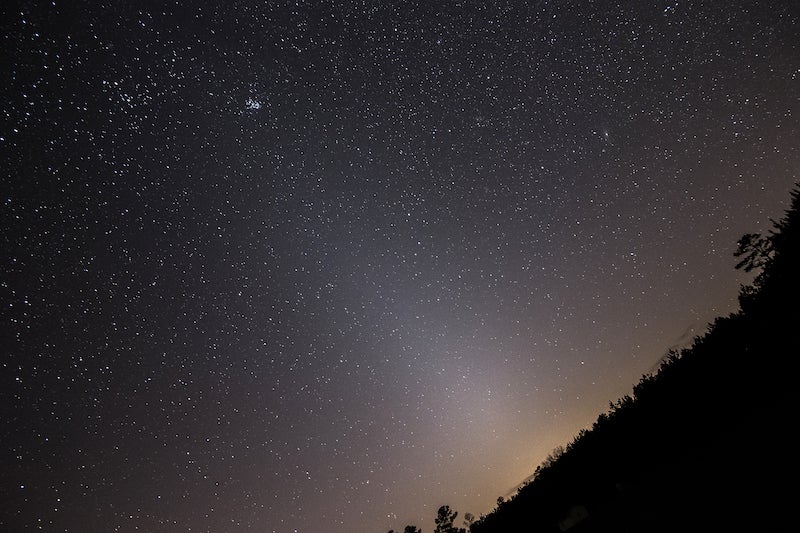
Comet Search: Fine or fantastic?
Expect a nice binocular comet — but hope and plan for the hyped-up eruption. Comet 12P/Pons-Brooks floats about 15° high in the west when the sky is fully dark some 90 minutes after sunset. That’s also the direction to travel to keep the most city skyglow behind you. Moonlight interferes after midmonth, but keep watching.
Picturesque wide-field viewing and imaging occurs when the crescent Moon joins Jupiter from the 12th to the 14th. Perhaps shoot a little earlier — say, 75 minutes after sunset — to catch some dim orange skyglow at the horizon and deep blue above. If we get a super-long ion tail, the blue streak could cross in front of the Andromeda Galaxy on the 8th and 9th. To see horns and gaps in the inner coma, bump the magnification past 100x and experiment with even higher power.
But wait, there’s more! Eighth-magnitude 144P/Kushida is stepping on the feet of Gemini, which carry wonderful star fields and nebular clouds. And 62P/Tsuchinshan 1 masquerades as one of the brighter Virgo Cluster galaxies. As the heart of the Milky Way rises before dawn, spot 7th-magnitude C/2021 S3 (PanSTARRS) running up the gorgeous Great Rift in Aquila, which sports the binocular star clusters NGC 6633 and IC 4756 in nearby Serpens.
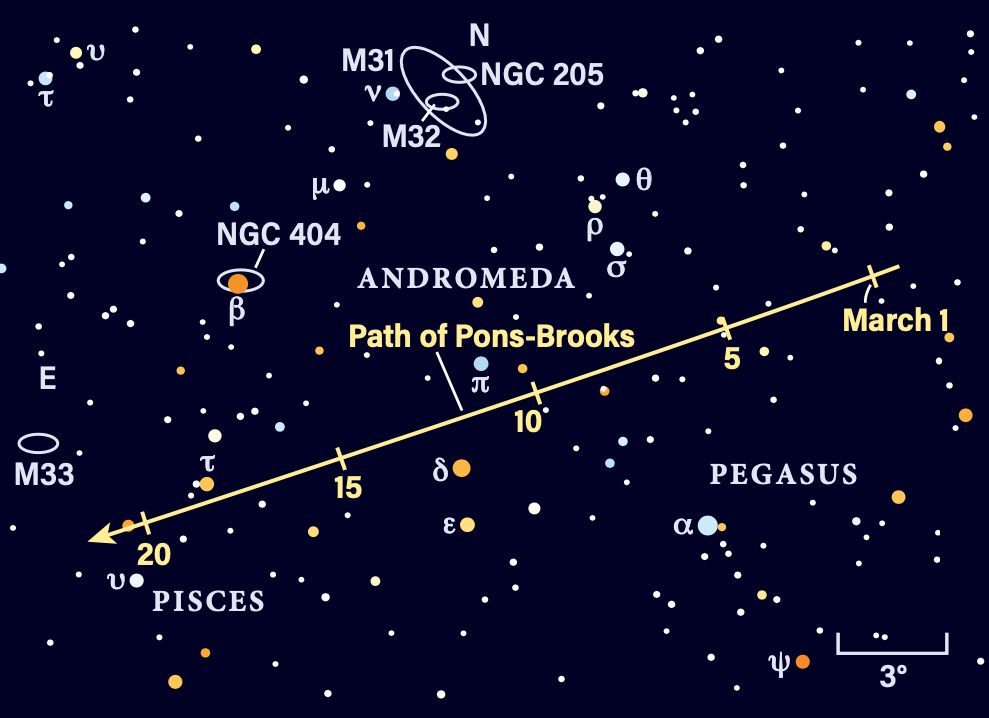
Locating Asteroids: From the city to galactic neighborhoods
Mild spring evenings are the best. 4 Vesta slides from the tip of Taurus’ horn, Zeta (ζ) Tauri, to the splashy but thin star cluster NGC 2129 at the feet of Gemini. Though a half-magnitude fainter than last month, Vesta still shines at about 8th magnitude, brighter than the rich but faint star cloud in this arm of our Milky Way Galaxy.
Vesta is pretty easy in the smallest of scopes from the suburbs. On the 16th, you can slide 4° south of the First Quarter Moon to land on it.
It only takes five dots of a pencil on paper and a couple of clear nights between the 13th and 16th, 21st and 23rd, or 29th and 31st to pick out the main-belt asteroid by its displacement. Next month it will appear to move fast enough to see it shift in a single observing session.
Discovered 217 years ago by Heinrich Olbers, Vesta is some 300 miles across, half the size of dwarf planet 1 Ceres. Olbers was looking for a “missing” planet between Mars and Jupiter, patiently comparing star charts to his eyepiece view.
